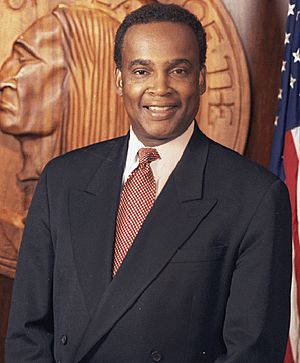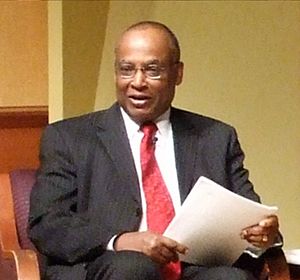Norm Rice facts for kids
Quick facts for kids
Norm Rice
|
|
|---|---|
 |
|
| 49th Mayor of Seattle | |
| In office January 1, 1990 – January 1, 1998 |
|
| Preceded by | Charles Royer |
| Succeeded by | Paul Schell |
| 53rd President of the United States Conference of Mayors | |
| In office 1995–1996 |
|
| Preceded by | Victor Ashe |
| Succeeded by | Richard Daley |
| President of the Seattle City Council | |
| In office January 3, 1984 – January 3, 1986 |
|
| Preceded by | Jeanette Williams |
| Succeeded by | Sam Smith |
| Personal details | |
| Born |
Norman Blann Rice
May 4, 1943 Denver, Colorado, U.S. |
| Political party | Democratic |
| Spouse | Constance Williams |
| Education | University of Washington, Seattle (BA, MPA) |
Norman "Norm" Blann Rice (born May 4, 1943) is an American politician. He is best known as the 49th mayor of Seattle, Washington. He served two terms, from 1990 to 1997. Rice was the first African-American to be elected mayor of Seattle.
Contents
Early Life and Education
Norm Rice was born in Denver, Colorado. He later moved to Seattle and attended the University of Washington. There, he earned a bachelor's degree in communications. He also earned a master's degree in public administration.
Before he started his career in politics, Rice worked in different jobs. He was a reporter for KOMO-TV News and KIXI radio. He also worked for community groups like the Seattle Urban League and the Puget Sound Council of Governments. These jobs helped him understand the needs of the city and its people.
Political Career
Rice's work in government began with the Seattle City Council. A city council is a group of people elected to make laws for a city.
Serving on the Seattle City Council
Rice was first elected to the Seattle City Council in 1978. He served on the council for eleven years. During his time there, he led important committees that handled the city's money and energy. He worked to make sure electricity costs were fair for everyone in Seattle.
He also took a stand on important social issues. He helped pass a law to support businesses owned by women and minorities. He also worked to stop the city from investing in companies that did business in South Africa. At the time, South Africa had a system of unfair racial separation called apartheid.
Becoming Mayor of Seattle
After an unsuccessful run in 1985, Rice ran for mayor again in 1989 and won. He was so popular that he was re-elected for a second term in 1993.
As mayor, Rice led Seattle during the 1990s. This was a time when many technology companies were growing, which helped the city. He focused on improving Seattle's downtown area. One of his major projects was helping to develop the Pacific Place shopping center.
During his time as mayor, Rice also became the President of the U.S. Conference of Mayors. This is a national group where mayors from across the country meet to solve problems.
In 1997, he made a fun guest appearance as himself on an episode of the popular TV show Frasier.
Life After Politics

After leaving the mayor's office, Rice continued to work in important roles. From 1998 to 2004, he was the president and CEO of the Federal Home Loan Bank of Seattle.
Later, he became the CEO of The Seattle Foundation, a non-profit group that helps the community. In 2010, President Barack Obama chose him to be part of the White House Council for Community Solutions. This council was created to find new ways to solve problems in communities across America.
Rice has also returned to the University of Washington to teach and share his experience with students. He has led projects about how people can get involved in their communities in the 21st century.
Honors and Awards
Norm Rice has received many awards for his leadership and service. Several colleges, including Seattle University and Whitman College, have given him honorary degrees.
Some of his other major awards include:
- The Municipal League of King County’s James R. Ellis Regional Leadership Award
- The American Jewish Federation’s Human Relations Award
- The National Neighborhood Coalition’s National Award for Leadership on Behalf of Neighborhoods
See also
- Timeline of Seattle, 1990s

